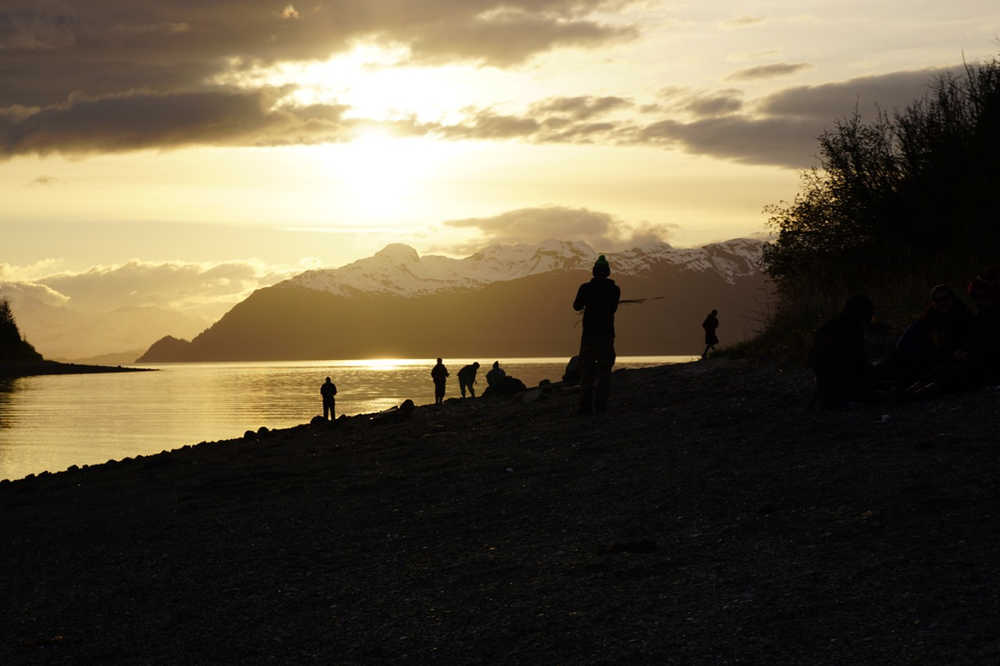The evening became chilly as the sun slowly sank below the distant edges of the Fairweather Range, but a tightly knit group of students, culture bearers, teachers, and new friends remained circled on the beach. This was the second and last night of the 2016 Journey to Homeland trip – and all were reluctant to leave the warmth of camaraderie to return to the waiting vessels.
This year’s adventure, “Singing Our Way Back to Homeland,” focused on creating works of art inspired by the magic of Glacier Bay as a dynamic landscape, a national park, and most importantly, an ancestral homeland.
The trip began on May 2 when students, culture bearers, and instructors boarded the M/V Sea Wolf and the M/V Valkyrie at the Hoonah City dock. Hours later, the boats drifted beside each other just past the entrance to Sít’ Eeti Geiyí – the Bay in Place of the Glacier ‐ to celebrate Returning to Homeland with songs both mournful and triumphant. During the long transit time between stops, students learned about language, traditional song structure, and protocol; journaled about their experiences; and began working on cultural gifts for the Opening Ceremony of the Huna Tribal House. Instructors also briefed students on how to capture digital images of the landscape and their adventures.
By late afternoon, the group was anxious to touch ground. Skiffs relayed participants and gear to a gently sloping beach in Sandy Cove where Darlene See, Gordon Greenwald, Daphne Wright, and Heather Powell helped students make skin drums. While drums dried in the waning sun, students explored the beach, hunkered by a campfire, sang songs, and shared stories.
On day two, the boats approached Reid Inlet – our intended destination – to discover a snow‐covered beach and high winds that would make hiking and exploring cold and difficult. Quickly adapting to new plans, the boats ventured on to Margerie Glacier. Almost all of the students had visited this iconic glacier aboard previous NPS‐sponsored catamaran trips, but this day, they lowered themselves into kayaks for a more personal exploration. Nine yellow kayaks paddled amidst icebergs to the kittiwake colony lining the southern edge of the glacier where Duffy Wright led the group in the T’akdeintaan Clan Sea Gals’ Cry. Threading through pathways between the icebergs, the group rafted up in front of the glacier to surf the small waves created as ice calved from the glacier face.
By late afternoon, the group was again gathered on a beach – this time in the upper west arm of the bay – to share thoughts and appreciations. Students spoke of their commitment to language and song and their connection to Glacier Bay – to Homeland. Powell reminded the students that “soon you will be the aunties and uncles, the grandmothers and grandfathers” responsible for sharing history, language, protocol, and song. Students all seemed to be prepared – and proud – to rise to this challenge.
On the last morning, the vessels moved to Bartlett Cove, where Ken Grant greeted the group. Walking from the Ceremonial Beach near the Glacier Bay dock along the Tlingit Trail, Grant shared the history of the Huna clans from their settlement at L’eiwshaa Shakee Aan through the painful ages of glacially driven exodus and Second Ice Age alienation, to the hard won return to homeland. Standing in front of the nearly completed Xunaa Shuká Hít – Huna Tribal House – Ken described the healing process of working collaboratively with the tribe, the National Park Service, and the clans to design and build this symbolic anchor for the Huna Tlingit. He shared his father’s words “Kooteiyi téik’ áwé kéi wooxeech” — “Even the smallest stone is turned” — to describe the monumental efforts he and others went to to achieve the Tribal House dream and encouraged the students to persevere in “finding the stone that is calling to you from the mountain top .”
In the late afternoon, the students grouped in a patch of sun to pull together the bits and pieces of vocables, lyrics, and rhythms they had been working on throughout the three day journey. From the edges of the spruce forest, new songs were drawn out, crafted by students who were proud and joyful to return to Homeland.
Toowú sigóo áyá.
Has du een yei haa teiyí.
T’akdeintaan.i yatx’I
A kaanax wutu.aadí
We are happy
When we are with our ancestors.
Children of the T’akdeintaan
As we walk through the land.
The three songs composed by the group will be performed at the Opening Celebration of the Xunaa Shuká Hít on August 25. Student photographs will be used in language classes.
The program was sponsored by a grant from the National Endowment for the Arts called Imagine Your Parks as well as the National Park Service (NPS). Hoonah City Schools and the Hoonah Indian Association provided in-kind support. The Hoonah Liquor Board and Huna Heritage Foundation provide funding for supplies and charter companies Sea Wolf Adventures and Adventures Afloat offset the costs of the charter vessels. Eight students chose to participate, including Vanessa Contreras, Jeff Devlin, Brandon Guthrie, Mary Jack, Treston Lafferty, Raymond Osborne, Randy Roberts, Nina Sanders, Sam Sheakley, and Kelsey Thein. Adult instructors included Hans Chester, Gordon Greenwald, Ben McLuckie, Mary Beth Moss, Heather Powell, Darlene See, and Daphne Wright.
• Article by Mary Beth Moss, cultural anthropologist with the National Park Service. Photos by Mary Beth Moss and Ben McLuckie.

